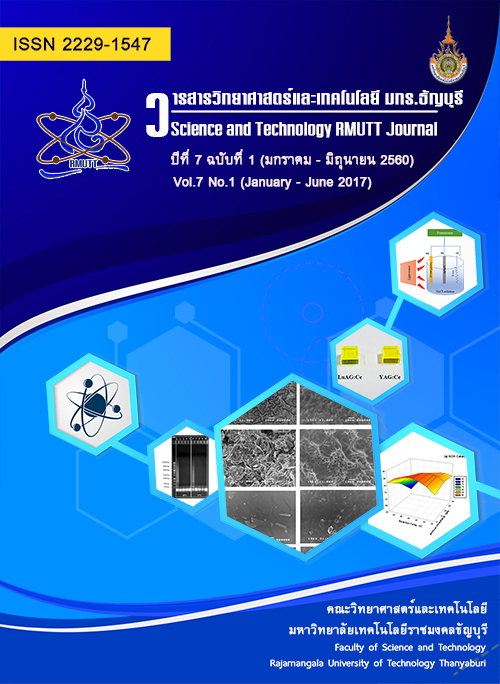Antidiabetic and Hypolipidemic Effects of Millettia leucantha Kurz Extract on Streptozotocin-induced Diabetic Rats
Main Article Content
Abstract
The effects of Millettia leucantha Kurz extract (MLE) on hypoglycemic and hypolipidemic effects in diabetic rats were carried out in male Wistar rats induced by a single intraperitoneal injection of 65 mg/kg b.w. of streptozotocin. The rats were randomly assigned into five groups (n = 8); namely: normal rats treated with distilled water, normal rats treated with MLE (300 mg/kg b.w.), diabetic rats treated with distilled water, diabetic rats treated with Glibenclamide (0.5 mg/kg b.w.) and diabetic rats treated with MLE (300 mg/kg b.w.). MLE was administered orally and daily to the rats for eight weeks. The blood glucose and body weight of the rats were measured weekly. After eight weeks of treatment, the lipid profiles were determined using an automatic blood chemical analyzer. The serum insulin were determined using the Radioimmunoassay kit. Statistical analysis of the data showed that MLE significantly (p<0.05) decreased blood glucose in the diabetic rats with a similar potent to Glibenclamide. And also, MLE significantly (p<0.05) decreased Total cholesterol (TC), Triglyceride (TG) and Low-density lipoprotein cholesterol (LDL-C). However, it increased the body weight, High-density lipoprotein cholesterol (HDL-C) and serum insulin in the diabetic rats. These results suggest that MLE has antidiabetic and hypolipidemic effects in the diabetic rats.
Article Details
References
วราภณ วงศ์ถาวราวัฒน์, วิทยา ศรีดามา และสมพงษ์ สุวรรณวลัยกร. คู่มือการใช้ยาทางอายุรกรรมและดัชนีค้นหาชื่อยา พ.ศ. 2544. พิมพ์ครั้งที่ 2. กรุงเทพฯ : จุฬาลงกรณ์ มหาวิทยาลัย. 2544.
Kuzuya T., Shoichi N., Satoh J., Kanazawa Y., Iwamoto Y., Kobayashi M., Nanjo K., Sasaki A., Seino Y., Ito C., Shima K., Nonaka K., and Kadowaki T. Report of the committee on the classification and diagnosis criteria of diabetes mellitus. Diabetes Research and Clinical Practice. 2002. 55 : 65-85.
Ozturk Y., Altan V.M. and Yildizoglu-Ari N. Duration-dependent changes in calcium responsiveness in the alloxan-diabetic rat intestine. Journal of Diabetes and Its Complications. 1996. 10(5) : 288-293.
สุมณฑา วัฒนสินธุ์. โรคเบาหวาน ตอนที่ 2. วารสารจาร์พา. 2545. 9(68) : 52-54 ; กันยายน-ตุลาคม.
ลือชัย ศรีเงินยวง และทวีทอง หงษ์วิเศษ. ยุทธศาสตร์เพื่อการดูแลสุขภาพตนเอง. กรุงเทพฯ: ศูนย์ศึกษานโยบายสาธารณสุข คณะสังคมศาสตร์. 2533.
รุ่งระวี เต็มศิริฤกษ์กุล วงศ์สถิตย์ ฉัวกุล มารุต พานทอง สันต์ กล่อมจินดา กนกวรรณ ทรง ผาสุก และตุลาภรณ์ รุจิระยรรยง. การ ศึกษาวิจัยความหลากหลายของสมุนไพร เส้นทางศึกษาธรรมชาติบริเวณรอบที่ทําการ เขตรักษาพันธุ์ฯ เขตรักษาพันธุ์สัตว์ป่าซับ ลังกาอําเภอลําสนธิ จังหวัดลพบุรี. รายงาน วิจัยฉบับสมบูรณ์. ภาควิชาเภสัชพฤกษศาสตร์ คณะเภสัชศาสตร์ มหาวิทยาลัยมหิดล. 2555 : 59.
สุภาวดี สำราญ. การวิจัยและพัฒนา กระบวนการผลิตน้ำผักสะทอนโดยการมีส่วน ร่วมของชุมชน: กรณีศึกษาประเทศไทยและสาธารณรัฐประชาธิปไตยประชาชนลาว. วิทยานิพนธ์ปรัชญาดุษฎีบัณฑิต สาขาวิชายุทธศาสตร์การพัฒนาภูมิภาค คณะมนุษยศาสตร์และสังคมศาสตร์ มหาวิทยาลัยราชภัฏเลย. 2552.
อุไรรัตน์ กาญจนขุนดี รุ่งระวี เต็มศิริฤกษ์กุล สุมาลย์ สาระยา ยุวดี วงษ์กระจ่าง และวงศ์ สถิตย์ ฉั่วกุล. ฤทธิ์ต้านเชื้อแบคทีเรีย และอนุมูลอิสระของสารสกัดสะทอน. ใน. รายงาน การประชุมวิชาการพฤกษศาสตร์แห่งประเทศไทย (ครั้งที่ 3: 2552). ภาควิชา พฤกษศาสตร์ คณะวิทยาศาสตร์ มหาวิทยาลัยมหิดล. กรุงเทพฯ, 25-27 มีนาคม พ.ศ. 2552 ; หน้า 7-12.
Phrutivorapongkul A., Lipipun V., Ruangrungsi N., Kirtikara K., NishikawaK., Maruyama S., Watanabe T., and Ishikawa T. Studies on the chemical constituents of stem bark of Millettia leucantha: isolation of new chalcones with cytotoxic, antiherpes simplex virus and antiinflammatory activities. Chemical and Pharmaceutical Bulletin. 2003. 51(2) : 187- 190.
Rayanil K., Bunchornmaspan P., and Tuntiwachwuttikul P. A new phenolic compound with anticancer activity from the wood of Millettia leucantha. Archives of Pharmacal Research. 2011. 34 (6) : 881-886.
Chatsumpun M. Chemical constituents of Millettia leucantha stemwood. Thesis Master's Degree of Science in Pharmacy, Chulalongkorn University. 2008.
Talubmook C., Forrest A. and Parsons M. Streptozotocin-induced diabetes modulates presynaptic and postsynaptic function in the rat ileum. European Journal of Pharmaco- logy. 2003. 469 : 153-158.
Sakuljaitrong S., Chomko S., Talubmook C., and Buddhakala N. Effect of flower extract from lotus (Nelumbo nucifera) on hematological values and blood cell characteristics in streptozotocin-induced diabetic rats. ARPN Journal of Science and Technology. 2012. 2(11) : 1049-1054.
อรพรรณ มาตังคสมบัติ. ยาที่ใช้ในโรค เบาหวาน. กรุงเทพฯ : แสงเทียนการพิมพ์. 2544.
Eidi A., Eidi M. and Esmaeili E. Antidiabetic effect of garlic (Allium sativum L.) in normal and streptozotocin-induced diabetic rats. Phytomedicine. 2006. 13 : 624-629.
Chatsumpun M., Sritularak B. and Likhitwitayawuid K. Phenolic compounds from stem wood of Millettia leucantha. Chemistry of Natural Compounds. 2010. 46(4) : 634-635.
Sharma B., Balomajumder C. and Roy P. Hypoglycemic and hypolipidemic effects of flavonoid rich extract from Eugenia jambolana seeds on streptozotocin-induced diabetic rats. Food and Chemical Toxicology. 2008. 46 : 2376-2383.
Fang X. K., Gao J. and Zhu D.N. Kaempferol and quercetin isolated from Euonymus alatus improve glucose uptake of 3T3-L1 cells without adipogenesis activity. Life Sciences. 2008. 82 : 615-622.
Maurya R. and Yadav P.P. Furanoflavonoids : an overview. Natural Product Reports. 2005. 22 : 300-423.
Rice-evans C., Miller N.J., Bolwell P.G., Bramley P.M., and Pridham J.B. The relative antioxidant activities of plant- derived polyphenolic flavonoids. Free Radical Research. 1995. 22 : 375-383.
Suttana W. Anticancer activities of flavonoids: mechanisms of actions. Srinagarind Medical Journal. 2013: 28(3): 567-582.
Hertog M.G.L., Hollman P.C.H. and Katan M.B. Content of potentially anticarcinogenic flavonoids of 28 vegetables and 9 fruits commonly consumed in the Netherlands. Journal of Agricultural and Food Chemistry. 1992. 41 : 2379-2383.
Beecher G.R. Flavonoid in Foods. In: Packer, L., Hiramatsu, M., Yoshikawa, T., editors. Antioxidant Food supplements in Human Health. Sandiego: Academic Press. 1999 : 269-281.
Rey A. I., Hopia A., Kivikari R. and Kähkönen, M. Use of natural food/plant extracts: cloudberry (Rubus chamaemorus), beetroot (Beta vulgaris “Vulgaris”) or willow herb (Epilobium angustifolium) to reduce lipid oxidation of cooked pork patties. LWT-Food Science and Technology. 2008. 38(4) : 363-370.
Sakuljaitrong S., Buddhakala N., Chomko S., and Talubmook C. Effects of flower extract from Lotus (Nelumbo nucifera) on hypoglycemic and hypolipidemic in streptozotocin-induced diabetic rats. International Journal of Scientific & Engineering Research. 2013. 4(7) : 1441- 1446.
Padee P., Nualkaew S., Talubmook C. and Sakuljaitrong S. Hypoglycemic effect of a leaf extract of Pseuderanthemum palatiferum (Nees) Radlk. In normal and streptozotocin-induced diabetic rats. Journal of Ethnopharmacology. 2010. 132 : 491-496.

